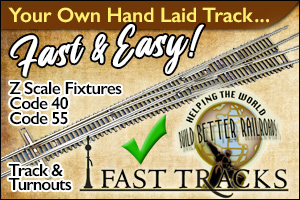Waterfront Project | Introduction
Welcome to the Z Scale Basics Waterfront Project, a freelance (or protolance) Z scale project layout featuring the Waterfront series of laser cut building kits from our sponsor, Micro-Trains Line. This series will take us from our protolance planning right through to the completion of a fully operational and sceniced Z scale layout. Like any large project in model railroading… it’s always much clearer and less daunting once you break it down into bite sized chunks.
Let’s start right from the beginning; I’m not one to stick to a plan for the sake of sticking to a plan. Whenever I build a layout or diorama I tend to make changes as I go along, lots of changes. I really like having the freedom to change a road into a river, an active spur line into a bit of abandoned history, etc. Although I do use track planning software and will loosely mock up my scenery on a computer… once I see a scene begin to take shape in real (1:220) life, I begin to see new scenic possibilities and adjust my plans.
For the construction of my scenery I tend to use expanding foam. Though not as precise initially as using rigid sheet foam when creating contours, hills and mountains, I really like getting in there and hand carving… seeing what shapes are suggested or present themselves. Often I’ll carve a bit too deep, removing too much foam and then find I need to re-foam and re-carve a scene until it feels right. Lots of foam chips end up on the floor using this method but I think it makes for a very organic feel. In Z scale every subtle (and not so subtle) ground change is important to the overall success of a scene.
Paying close attention to the subtle ground changes on your layout from the very beginning has the effect of making you more aware of the rest of your layout. No aspect of your layout is unimportant: good trackwork, ballast and ground cover are just the beginning. Once you become more aware of the subtleties, you’ll naturally begin to see and to add more depth to your scenes.
Prototype, freelance or protolance model railroad… confused? Don’t be, as these are pretty simple concepts in model railroading though the exact definitions can get a bit fuzzy, depending on whom you talk to! In prototype model railroading, specific eras, locations, equipment and railroad practices are closely followed. On a strict prototype model railroad set in the 1950s for example, you wouldn’t see a GP35 locomotive as these were built in the early to mid-1960s.
Freelance model railroads, on the other hand, throw the rule book clean out of the room… often with great results. Say you just want to lay some track, add hills, a lake and maybe a small town with a nice white church in the middle of it all… just to keep your little residents upstanding. Maybe you’d like to run an old time steam Mogul next to a GG1 and add a modern SD40-2 just for some spice. Why not? It’s your railroad after all and these happen to be three terrific locomotives. If this is your direction, you’re probably a freelancer.
The third model railroad layout concept, the protolance layout, seems to have begun appearing as a semi-defined niche around 2005 or so, and it’s where I find myself and our Waterfront Project. While there is no ironclad or definitive definition, I tend to think of protolancing as loosely modeling a specific railroad, area or time period, and taking artistic liberties where needed. It’s kind of the best of both worlds really, I get to do some research into an historical railroad topic and let my imagination run free all at the same time.
Now that I’ve decided the Waterfront Project will be a protolance layout, it’s time to make some initial decisions. The Waterfront series of buildings from Micro-Trains initially suggests to me a Northwestern scene, somewhere in the Oregon or Washington State coastal area. As well as a Northwest layout would work for our Waterfront Project… I’m thinking of throwing a curveball and going with a Deep South layout with an emphasis on Florida.
With our grouped image galleries you can navigate using your keyboard’s left and right arrows or by clicking on the left or right side of the image.
I’ve chosen Florida for a couple of reasons, first of which is I’m personally looking to move down to Florida, so it’s been on my mind for some time now. In creative writing there’s a saying… “Write what you know”. I’ve spent some time in Florida on both coasts and I have to admit I find it a fascinating place. While I don’t know it as well as native Floridians, I do feel a certain draw to the area.
Next I’d like to find an industry or area that I think would fit well with the Micro-Trains Waterfront kits. This is where I’ll begin to apply some historical research as well as freelancing to the layout. Over the years Florida has had lots of interesting waterfront industries: sponge fishing in Tarpon Springs, turtle cannery in the Keys, commercial fishing all along both coasts as well as inland along rivers. I can also add a bit of sugar cane, citrus and pineapple industries in a pinch. I can work with this! I’ll be basing this layout on the East Coast of Florida as there is currently a Class II railroad (formerly a Class I) that hugs the coastline from Jacksonville to Miami. The railroad actually extended through to the Keys until the Labor Day Hurricane of 1935 ended the Key West portion of the line.
So I now have a general location… more of a feel really as I’ll be taking elements from all over the South and combining them into the Waterfront Project.
Category: Z Scale Basics























